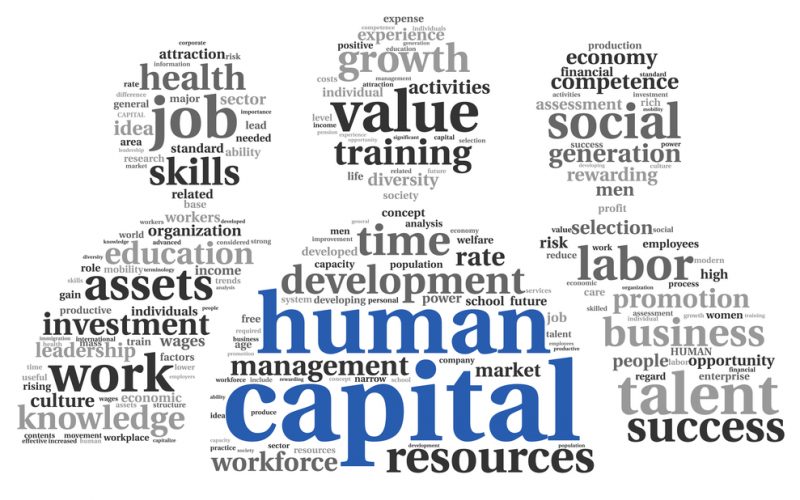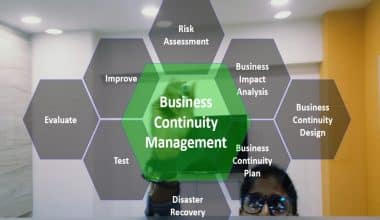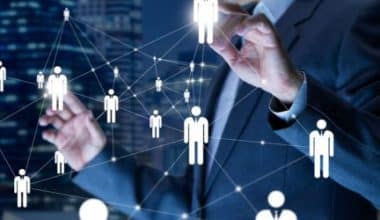In its most basic form, “human capital” refers to the group of people who work for or are qualified to work for a company, also known as the “workforce.” In a broader sense, the various elements required to create an adequate supply of available labor form the foundation of human capital theory and are critical to the global economy and social health of nations. Investing in these characteristics increases economic output. Because workers are not separate from these assets, the investments are referred to as human capital. In a corporation, this is known as talent management, and it falls under the purview of the human resources department.
What Is Human Capital?
Human capital refers to intangible assets and characteristics that improve worker performance and benefit the economy. These characteristics are inextricably linked to the people who receive or possess them.
Nobel laureates and University of Chicago economists Gary Becker and Theodore Schultz developed the theory of human capital in the 1950s and early 1960s.
Becker realized that investing in workers was the same as investing in capital equipment, which is another factor of production. Both are assets that yield income and other outputs.
Becker distinguished general and specific human capital.
- Specific Human Capital: Training or education that benefits only one company is referred to as specific human capital.
- General human capital: skills or abilities that benefit individuals in any company.
Becker discovered that businesses were more likely to pay for specific human capital investments, whereas individuals paid for general human capital investments. Companies were less interested in investing in employees who could be poached by competitors.
Types of Human Capital
Any human quality or value that can improve economic output and productivity is referred to as human capital.
Quantifying these intangible assets, which cannot be separated from individual workers, can be difficult. However, they consistently lead to increased economic performance.
They can include characteristics such as:
- Education
- On-the-job or technical training
- Health
- Mental and emotional health
- Punctuality
- Problem-solving
- People management
- Communication abilities
Investing in these qualities improves the labor force’s abilities. As a result, the economy produces more and individuals earn more money.
Education and Human Capital
Becker’s study was centered on education. Becker emphasized that the cost of education included both time and money. Students who pursue an education forego the opportunity to work, travel, or have children. People would only pursue an education if the potential income gain outweighed the cost.
Becker’s research was limited in that it focused much on the education of white men, rather than diverse groups of people. Becker’s theory explained how investing in education benefited people, companies, and countries. The majority of the states that spend the most on education also have median household incomes that are higher than the national median, which in 2019 was $65,712.
States With Top Education Spending, FY 2018
| State | Education Spending Per Pupil | Median Household Income |
| New York | $24,040 | $67,844 |
| District of Columbia | $22,759 | $85,203 |
| Connecticut | $20,635 | $76,348 |
| New Jersey | $20,021 | $81,740 |
| Vermont | $19,340 | $60,782 |
| Alaska | $17,726 | $74,346 |
| Massachusetts | $17,058 | $79,835 |
| New Hampshire | $16,893 | $74,991 |
| Pennsylvania | $16,395 | $60,905 |
| Wyoming | $16,224 | $61,584 |
| Rhode Island | $16,121 | $64,340 |
Data from the United States Census Bureau: School System Spending Per Pupil in the United States by Region; 2018. Median Household Income in the United States States with greater education levels has higher earnings on average.
Economic Mobility and Human Capital
Investment in human capital benefits both individual individuals and the economy in which they participate by increasing earning potential and the ability to develop wealth. This is especially true in the field of education.
According to a Federal Reserve study, the typical family income of those with a college degree in 2019 was $95,700, compared to $45,800 for households with only a high school diploma.
This provides individuals with enough money to save and accumulate wealth, which is essential for economic mobility.
Better Early Childhood Education
Families led by educated parents earn more than those led by uneducated parents. They are more likely to reside in wealthy neighborhoods with superior schools or to be able to afford private schools.
These children are then educated more effectively than children of lower-income parents. As a result, children of more educated parents have higher earning potential and economic mobility.
College’s Effect on Upward Mobility
When a child is born into a family without a college degree, further education boosts the upward mobility effect. When the youngster receives a diploma, the entire family gains riches.
According to Federal Reserve research, a child receiving a college degree can improve family wealth by 20 places in the rankings. Families with both parents and children graduating from college advanced only 11 points in the rankings.
In contrast, a lack of a college degree might have a negative impact on one’s mobility.
Children of college-educated parents who did not complete college lost 18 places in the wealth rankings. Children whose parents did not complete college lost ten places in the wealth rankings.
Investing in Education in the United States
The United States does not invest as much in human capital, such as education, as other developed countries do.
Between 2012 and 2017, public spending on education in the United States increased by around 10%. This was slightly higher than the overall average for all countries polled, however other developed countries boosted spending considerably more.
Higher education in the United States is more expensive than in many other nations, which is one reason for reduced education investment. For the 2020-2021 academic year, the average yearly cost of tuition, fees, housing, and board for a four-year public institution was $22,180 for state residents and $38,640 for out-of-state students.
As a result, children from wealthy homes are more likely to attend college. This reduces economic mobility in the United States by limiting who can attend college. It also hinders human capital expansion, which in turn affects economic progress.
Human Capital Measurement
Human capital can be calculated in monetary terms as the total potential future earnings of the working-age population. (However, this only accounts for a portion of human capital and is a crude measure.)
Human Capital at the Office for National Statistics in the United Kingdom
The decline in UK human capital reflects the period’s growth in unemployment and fall in real wages. It should be highlighted that focusing on projected earnings is a skewed perspective on human capital. Earnings do not always accurately reflect all dimensions of human capital. The OECD considers many methods of measuring human capital using a variety of metrics.
Factors Influencing Human Capital
- Qualifications and skills
- Levels of education
- Experience at work
- Communication and social skills
- Intelligence
- Social and emotional intelligence
- Judgement
- Personality – hardworking and harmonious in the workplace
- Personality traits and habits
- Creativity. Capability to develop new working practices/products.
- An individual’s fame and brand image For example, celebrities may be compensated to endorse a product.
- Geography – Expectations and attitudes can be influenced by social peer pressure in the local area.
Human Capital in the Primary and Secondary Sectors
Human capital was easier to quantify in agriculture and manufacturing. An assembly line worker’s human capital could be quantified in basic terms of productivity, such as the number of widgets produced per hour. Human capital in mining may be strongly tied to physical strength and the amount of coal produced per day.
Human Capital in the Tertiary Sector and the Knowledge Economy
The tertiary/service industry offers a wider range of professions that demand a variety of abilities. These abilities and attributes are frequently more difficult to quantify in terms of production. A teacher’s human capital, for example, cannot be quantified by a university degree and A-Levels. Some of the strongest academics may lack some teaching qualities, such as empathy and the ability to inspire and lead a class.
In a career such as management, vital attributes will include interpersonal skills, the ability to work in a team, and the capacity to problem-solve creatively.
In other words, as the economy has grown, the definition of human capital has expanded to embrace a broader range of capital abilities and characteristics.
Human capital has become a more common economic notion during the 1960s/70s, as the rising ‘knowledge economy’ makes greater use of a broader range of human capital.
How to Boost Human Capital
#1. Specialization and labor division
Specialization enables people to focus on specialized activities and increases skill specialization. (However, specialization can lead to tedious, repetitive jobs and little skill development for employees.)
“The results of the division of labor appear to have resulted in the greatest advance in the productive powers of labor.”
#2. Education.
Basic education to increase literacy and numeracy has a significant impact on the foundation of human capital.
#3. Vocational education.
Direct training for job-related skills such as electrical, plumbing, and nursing. A skilled career necessitates specific vocational training.
#4. A creative environment.
An education that encourages pupils to think outside the box has the potential to enhance human capital in ways that rote learning and an impressive accumulation of knowledge may not.
#5. Infrastructure.
Human capital is influenced by an economy’s infrastructure. Good transportation, communication, mobile phone availability, and internet access are critical for the development of human capital in developing economies.
#6. Competitiveness.
Individual ingenuity and entrepreneurship are likely to be stifled in an economy dominated by state monopolies. An environment that supports self-employment and the formation of businesses allows an economy to make better use of its potential human capital.
Importance of Human Capital
#1. Unemployment caused by structural factors.
Individuals whose human capital is unsuitable for modern businesses may struggle to get work. Rapid deindustrialization has left many manual workers struggling to survive in a radically different labor market, which is a major challenge in modern economies.
#2. Workplace quality.
In today’s economy, there is a growing disparity between low-skilled, low-paying temporary work and higher-skilled, higher-paying permanent ones (gig economy). Workers with high levels of competence and creativity have more chances for self-employment or favorable employment contracts.
#3. Productivity and economic growth
Long-term economic growth is increasingly dependent on human capital upgrades. A more educated, imaginative, and creative workforce can contribute to higher labor productivity and economic growth.
#4. Human capital emigration
Because of globalization and increased labor mobility, talented employees can now move from low-income countries to higher-income countries. This can have a negative impact on developing economies by causing them to lose their greatest human resources.
#5. Raw materials are scarce.
Economic development in countries with limited natural resources, such as Japan, Taiwan, and Southeast Asia. Count on highly skilled and imaginative staff to add value to raw materials during the production process.
#6. Sustainability
This is defined as “what we leave to future generations; whether we leave adequate resources of all types to give them with possibilities at least as large as the ones we have had.” United Nations, 2012.
Different Perspectives on Human Capital
Theodore Schultz’s 1961 book “Investment in Human Capital” was an early proponent of the theory. He stated, “
“While it is evident that people develop important skills and knowledge, it is not obvious that these skills and knowledge are a type of capital, and that this capital is largely the result of a conscious investment.”
“Human Capital” by Gary Becker (1964) Human capital, in his opinion, is determined by education, training, and medical care, and is effectively a means of production. Increased human capital explains the income disparity for graduates. Human capital is equally essential in affecting economic growth rates.
Different sorts of human capital, according to Howard Gardener. Gardener highlighted the various sorts of human capital. One could get more schooling but be a bad boss. An entrepreneur who is successful may have no formal schooling. Human capital is not a one-dimensional entity.
Spence Point of View – Observable indicators of human capital, like schooling, serve primarily as a signaling role.
Human Capital Assessment
#1. Upbringing in society.
According to sociologist Pierre Bourdieu, human capital is intimately tied to social upbringing. This has an impact on cultural, social, and symbolic kinds of capital. For example, in the United Kingdom, Old Etonians and Oxbridge graduates develop confidence and social capital as a result of having the correct social networks.
#2. Signaling:
The idea that what constitutes human capital is often just ‘signaling’ is related to the social capital of attending the proper school. For example, obtaining an Oxbridge degree raises one’s status in the workforce and allows the graduate to earn a better wage. Three years of studying modern history/PPE, on the other hand, may provide only a modest amount of knowledge directly connected to the work environment.
#4. Discrimination.
Wage and job opportunity disparities are not only the result of variations in human capital, but can also be the effect of discrimination, labor market flaws, or non-monetary perks of occupations.
Human Capital Theory
According to human capital theory, the value of these investments to employees, companies, and society as a whole may be quantified. Sufficient investment in people, according to human capital theory, will result in a developing economy. Some countries, for example, provide free college education to their citizens because they recognize that a better-educated population earns and spends more, so encouraging the economy. The human capital theory is an extension of human resource management in the discipline of business administration.
The human capital theory is typically attributed to Adam Smith, the “founding father of economics,” who defined it in 1776 as “the acquired and usable talents of all the inhabitants or members of the society.” Smith proposed that wage disparities were dependent on the relative ease or difficulty of doing the jobs involved.
Marxist Theory
In 1859, Prussian philosopher Karl Marx proposed the concept of human capital, dubbed “labor power,” by claiming that in capitalist systems, people sell their labor power—human capital—in exchange for wealth. Unlike Smith and other early economists, Marx identified “two disagreeably frustrating facts” concerning human capital theory:
Workers must actively work—that is, use their minds and bodies—in order to earn a living. The mere ability to perform a task is not the same as actually performing it.
Workers cannot “sell” their human capital in the same way that they can sell their homes or land. Instead, individuals form mutually advantageous partnerships with companies to use their abilities in exchange for wages, similar to how farmers sell their crops.
Marx went on to explain that for this human capital contract to succeed, employers must make a net profit. In other words, workers must perform work that is above and beyond what is they need to merely retain their labor power. When labor expenditures, for example, surpass revenue, the human capital contract fails.
Marx further clarified the distinction between human capital and enslavement. Enslaved people—human capital—can be sold, unlike free labor, despite the fact that they do not generate an income.
Theory of the Present
The human capital theory is frequently deconstructed today in order to measure “intangibles” such as cultural capital, social capital, and intellectual capital.
Culture Capital
Cultural capital is a mix of information and intellectual skills that improves a person’s capacity to advance in society or do economically beneficial employment. In terms of economics, greater education, job-specific training, and intrinsic abilities are common ways for people to accumulate cultural capital in anticipation of earning higher earnings.
Social Capital
Social capital refers to long-term beneficial social interactions, such as a company’s goodwill and brand awareness, which are important components of sensory psychological marketing. It differs from human assets such as celebrity or charisma, which cannot be taught or passed to others in the same way that skills and knowledge can.
Intellectual Capital
This is the extremely intangible value of everything everyone in a company understands that gives the company a competitive advantage. Intellectual property is a common example—creations of the employees’ minds, such as inventions and works of art and literature. Unlike human capital assets like skill and education, intellectual capital stays with the company even after the workers leave. It is often protected by a patent and copyright laws, as well as non-disclosure agreements signed by employees.
The Role of Human Capital in Today’s World Economy
As history and experience have proven, economic prosperity is the key to improving people’s living standards and dignity around the world, particularly in impoverished and emerging countries.
The characteristics that contribute to human capital, particularly education and health, also contribute directly to economic success. Countries with inadequate or unequal access to health or educational resources also have weak economies.
As in the United States, the countries with the most successful economies have continued to expand their investments in higher education while experiencing consistent growth in college graduates’ starting salaries. Indeed, most poor countries’ first step toward progress is to enhance their people’s health and education. Since World War II, Japan, South Korea, and China have adopted this technique to erase poverty and become some of the world’s most powerful actors in the global economy.
In order to highlight the importance of education and health resources, the World Bank produces an annual Human Capital Index Map that shows how access to education and health resources affects productivity, prosperity, and quality of life in nations around the world.
In October 2018, World Bank President Jim Yong Kim warned that “in countries with the lowest human capital investments today, our analysis suggests that the workforce of the future will only be one-third to one-half as productive as it could be if people enjoyed full health and a high-quality education.”
Is it true that Human Capital Depreciates?
Human capital, like any other asset, is subject to depreciation. This is frequently quantified in terms of wages or the capacity to remain in the workforce. Human capital can depreciate in a variety of ways, including unemployment, injury, mental decline, and an inability to keep up with innovation.
Consider the case of an employee with specialized talent. They may be unable to maintain these levels of specialization if they are unemployed for an extended length of time. This is because their skills may no longer be in demand when they return to work.
Individuals’ human capital may degrade if they are unable or unwilling to accept new technologies or procedures. The human capital of someone who does adopt them, on the other hand, will.
Human Capital Theories Critisisms
Many professionals who work in education and training have been critical of the human capital theory. The theory was criticized in the 1960s partly because it legitimized bourgeois individualism, which was viewed as greedy and exploitative. The bourgeoisie was made up of middle-class people who were thought to exploit the working class. The theory was also thought to blame people for any flaws in the system and to turn employees become capitalists.
What Are Some Human Capital Examples?
Communication skills, education, technical abilities, creativity, experience, problem-solving skills, mental health, and personal resilience are all examples of human capital.
Human Capital Risk
The gap between a company’s or organization’s human capital requirements and its workforce’s existing human capital is referred to as human capital risk. This chasm can lead to inefficiency, failure to meet goals, a bad reputation, fraud, financial loss, and final closure. An organization should teach, foster, and support its personnel to mitigate and eliminate human capital risk.
What is talent development?
Talent development is the process of providing employees with the skills and knowledge they need to succeed and grow in their careers.
What is talent optimization?
Talent optimization is the process of aligning employee development and performance with the goals and objectives of the organization.
How can organizations measure the return on investment in human capital?
Organizations can measure the return on investment in human capital by tracking metrics such as employee engagement, productivity, and turnover.
What are the challenges of human capital management?
The challenges of human capital management include managing the changing needs of a diverse workforce, balancing the needs of employees with the goals of the organization, and staying up-to-date with rapidly changing technology.
How can human capital management support diversity and inclusion in the workplace?
Human capital management can support diversity and inclusion in the workplace by creating a culture of respect and inclusion, providing equal opportunities for all employees, and addressing any unconscious biases in HR processes.
What is the role of HR in human capital management?
HR plays a critical role in human capital management by leading and executing strategies to attract, retain, and develop employees, and by leveraging technology to provide data-driven insights.
How can human capital management improve employee engagement and satisfaction?
Human capital management can improve employee engagement and satisfaction by providing opportunities for career growth, recognizing and rewarding performance, and creating a supportive and inclusive work environment.
Important Takeaways
Human capital is the monetary value of labor abilities and characteristics that drive productivity. These are characteristics like education, health, and on-the-job training. Human capital is intangible, but it is inextricably linked to labor.
Education is one of the most essential components of human capital, as it leads to higher economic output, higher individual income, and more economic mobility for families.
In the United States, low educational investment combined with the high expense of higher education results in limited economic mobility and stagnant human capital growth. As a result, the potential for economic expansion is limited.
Human Capital FAQ’s
How is human capital formed?
Human capital formation is the process of gradually increasing the stock of human capital. It can be developed by providing improved education, health care facilities, and so on, in order to create a skilled, trained, and efficient labor force. Furthermore, on-the-job training allows individuals to keep their abilities up to date.
What are the disadvantages of human capital?
The drawback is that the concept of human capital can be taken too far, leading to the belief that every difference in remuneration is related to human capital. We cannot always assume that disparities in employee remuneration are due to talent, but it could also be attributable to other factors.
What country has the highest human capital?
The Human Capital Index is a number between 0 and 1, with 1 indicating that all potential has been realized. Singapore ranked #1 on the Human Capital Index in the initial rankings.





